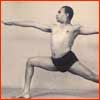Prashant Iyengar: Master Chef of Inspiration
Observing and participating in Prashant’s classes are two totally different things. Feeling weak after five days of a very bad cold, today I decided to watch it. The benefits were that I could write his ideas as he spoke. The bad part was that I was writing, and not really doing and feeling what he was instructing. It was also difficult to sit on the stairs and be mindful of students coming and going into the second floor space for classes. It was, however a wonderful experience to watch a room full of students from all walks of life, from all corners of the world, the young, the older, and all body shapes and constitutions. It was educative to watch many variations being modified according to people’s conditions. Everyone was really doing their own practice, but like an expert chef, being guided to have a delectable outcome.
I watched as some faces went inwards, and others were distracted by their neighbors. I watched the students that knew exactly how to set up for the requested pose, and the ones that seemed a little lost, but took their time to watch others to see what the pose was. Possibly a language issue, or confusion, or not knowing what is being requested. The beauty of it all is that without them knowing it, the quick students help the ones that need clarification. The faster they get into their poses, the faster the confused ones can follow. But no one is left behind. Like a Montessori school, where the older children help the younger ones, the seasoned students help the newer ones.
I was also able to watch Prashantji working the room to make sure everyone has space, but also to observe that the students are all with him. Finding empty ropes to be claimed, offering options for everyone in the room. The sense of inclusiveness is felt in this hall. Some can stay in Sirsasana, and he offered those that could to stay and explore longer doing possible variations with abdominal awareness. He encouraged the ones that couldn’t stay longer to become sensitive to when its time to come down. The message was repeated in various ways, in all the postures, and giving the beginners enough to start working on the subtle teachings he offers, but also deepening the experience for those who have been his students for over thirty years.
His main point today was to observe the role of the abdomen in every pose. What can the abdomen do for you? What can the abdomen do for the breath? What can the abdomen do for your physiology? What can the abdomen do for your mind? What can the abdomen do for your posture? What is voluntarily done and what is involuntarily done?
If we focus our practice on what we can do and how much we can do, our practice becomes mundane. If we observe our abdominal conditions and abdominal breath aspects, our practice can evolve. Don’t just be thinking about what you can do. Find out what the abdomen can do. Create abdominal Kriyas where abdomen can become beneficiary and or benefactor. And create associated conditions with other parts of the body to help the abdomen. It can be rectified, it can be pacified.
He spoke of the postures being able to become magical, because of their remedial effects. We can go to a gastroenterologist to have an operation, or we can find out how your limbs, back, breath are operating on the abdomen.
He told us that there are different degrees in understanding the body. When were in grade school, we learn where the heart is. What is the cardiologist study of the heart? Heart is the same, it doesn’t change. The study changes. Same as the abdomen. How much is there for you to do explore? A Doctor can understand the body, and he studies anatomy very well, and can even understand other bodies. But can he understand his own body?
Get on the track of learning YOG.
Abdomen can learn at primary level
And middle level
High school level
College level
Doctorate level
Abdominalology
Abdominosophy
In our practice, we should have our mind operating and being operated.
Finally, What is the creed for Savasana? It should be abdomen generated. Abdominosofy for two hours. Identify the concept here. The scheme, the theme, the perspective.
Sequence (switching to accommodate everyone)
Sirsasana AMS or Rope Sirsasana
Sirsasana or bharadvajasana (those who wanted could repeat Sirsasana)
Parsva Utthita Hasta or upavistha Konasana or ropes 1
Rope people feet to wall knees on bolster
Marichyasana 1 (those that could bind did.)
Marichyasana 3
Ardha Matsyendrasana
Supta Padangusthasana wall top foot on rope, bottom foot with belt or in the middle of the room
Brick Setu Banha
Or box Setu Bandha
(Padma kriya can be done on the box or brick)
Or bench Setu bandha
Or pavanmuktasana
Ground the mat
Lay down for a while.
Again work on generating Savasana from the abdomen. To the abdomen from the abdomen by the abdomen.
Note: Prashantjis classes are recorded and available for purchase at the institute. This is not a transcription, it’s just me humbly sharing my notes with those who may be interested. The best way to savor Prashant’s teachings is to experience them in person. It’s like if I told you about my new favorite restaurant in Pune, Tien. Even if I described the broccoli and paneer in pumpkin sauce, you would be unable to taste it. And the Belgian chocolate tarte? And even if I sent you a picture, It’s just one of those things. You must savor for yourself. ❤️



Comments
Post a Comment